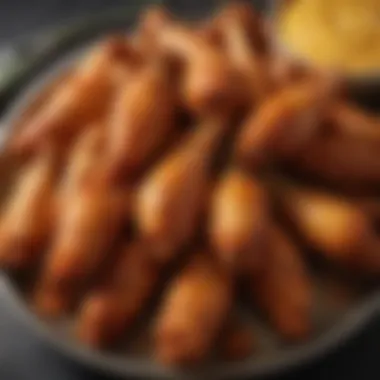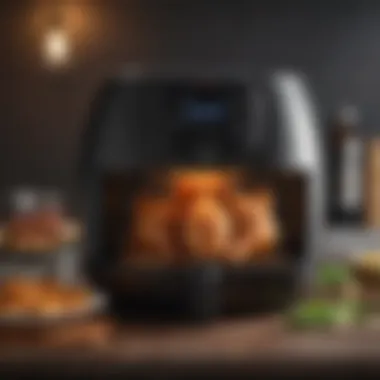Mastering Air Frying Chicken Wings: Tips & Techniques


Intro
Air frying has become a popular cooking method due to its convenience and health benefits. One dish that particularly shines in an air fryer is chicken wings. They can be crispy on the outside while remaining tender and juicy on the inside. Understanding how to properly air fry chicken wings requires attention to details like timing, temperature, and seasoning. In this guide, we will explore these factors comprehensively, ensuring that home cooks can achieve the best results each time.
Ingredients Breakdown
Primary Ingredients
When air frying chicken wings, the main ingredient is obviously the chicken wings themselves. Look for fresh or frozen wings. Fresh ingredients typically yield the best texture and flavor. Choose wings that are uniform in size for even cooking.
Optional Ingredients
There are numerous ways to enhance chicken wings. You might consider adding:
- Oil: A light coating of oil can help achieve crispiness.
- Salt and Pepper: Basic seasoning to elevate flavors.
- Garlic Powder: A subtle and delicious seasoning option.
- Buffalo Sauce: For those who prefer a spicy kick.
Essential Kitchen Tools
Having the right tools can make the air frying process more efficient and enjoyable:
- Air Fryer: Essential for cooking the wings to perfection.
- Tongs: Useful for flipping wings during cooking.
- Meat Thermometer: Ensures the chicken is cooked thoroughly.
- Mixing Bowl: Helps in marinating the wings.
Step-by-Step Preparation
Prepping the Ingredients
Start by preparing the chicken wings. If frozen, ensure they are completely thawed. Pat them dry with paper towels to remove excess moisture. This step is vital for achieving that crispy texture. You can choose to marinate them for a couple of hours or overnight to deepen the flavor.
Cooking Techniques and Methods
Set your air fryer at a temperature of 375°F. This is optimal for cooking chicken wings. Place a single layer of wings in the basket, ensuring they are not overcrowded. Cook for about 25 to 30 minutes, shaking the basket halfway through to ensure even cooking. Using a meat thermometer, confirm that the internal temperature has reached 165°F.
Assembly and Presentation Tips
Once cooked, let the wings rest for a few minutes. This allows juices to redistribute. Serve with a selection of dipping sauces like ranch or blue cheese. Adding celery and carrot sticks on the side not only enhances the presentation but also complements the meal well.
Dietary Considerations
Gluten-Free Options
Air frying offers an excellent opportunity for gluten-free cooking. Stick to natural seasonings and avoid pre-made sauces that may contain gluten.
Vegetarian and Vegan Substitutes
If you are looking for alternatives, consider using cauliflower wings. They can absorb flavors and seasonings beautifully, providing a similar texture when air fried.
Nutrition Facts & Nutritional Considerations
Chicken wings are a good source of protein but can be high in fat, especially if fried traditionally. Air frying reduces the overall fat content significantly. It is important to balance your meal with healthy sides.
Variations and Customizations
Flavor Enhancements
Experiment with different flavors by adding spices and seasonings. Consider using:
- Cajun seasoning
- Honey garlic sauce
- Teriyaki sauce
Alternative Cooking Methods
While air frying is efficient, consider grilling or baking chicken wings for different flavor profiles.
Pairing Suggestions (Sides, Drinks, etc.)
Wings go well with various sides like:


- French fries
- Coleslaw
- Nachos For drinks, pairing with a cold beer or sparkling water can enhance the meal experience.
Common Answers to Common Questionss and Troubleshooting
Frequently Asked Questions
People often ask about achieving the perfect crispiness. The secret lies in the moisture in the wings and the air fryer's circulation.
Common Mistakes to Avoid
- Overcrowding the basket: This prevents even cooking.
- Skipping the seasoning: Flavor is key to enjoying chicken wings.
Solutions to Potential Problems
If wings are not crispy enough, increase the temperature slightly or extend cooking time by a few minutes. If they are too dry, ensure proper marinating and do not overcook them.
Mastering air frying chicken wings takes practice. By following these detailed steps and tips, you can elevate your cooking game.
Prolusion to Air Frying Wings
Air frying chicken wings has rapidly grown in popularity, transforming how many cook and enjoy this beloved dish. This method allows for crispy yet tender wings, often with less oil than traditional frying methods. In this article, we will delve into the specifics of air frying chicken wings, examining the various benefits, cooking techniques, and tips that can enhance your culinary experience.
Air frying works by circulating hot air around food, creating a crispy exterior. This method is not only efficient but also healthier, making it attractive to those seeking to enjoy their favorite meals without the excess fat. For chicken wings, this process yields a delightful crunch that can satisfy even the most discerning palate. Understanding this cooking style is essential for anyone looking to produce restaurant-quality wings at home.
Why Choose Air Frying?
Air frying provides distinct advantages over other cooking methods when it comes to chicken wings:
- Healthier Option: Typically, air frying requires significantly less oil compared to deep frying, which can lead to reduced calorie intake without sacrificing texture.
- Convenience: Air fryers are often easier to use and clean than traditional frying methods, which require more preparation and cleanup.
- Speed: Cooking with an air fryer is generally quicker, making it a time-saving method for busy cooks.
These factors contribute to the growing favor of air fryers in many kitchens today.
The Appeal of Chicken Wings
Chicken wings hold a special place in many cuisines, with their versatility and flavor. They can be seasoned, sauced, or served plain, allowing for a wide range of tastes and preferences. Here are a few reasons why chicken wings are so appealing:
- Social Food: Chicken wings are often enjoyed in gatherings, parties, or sports events. They are easy to share and perfect for communal eating.
- Flavor Variety: From spicy buffalo sauces to tangy barbecue, there is almost no limit to the flavor combinations possible with wings.
- Affordability: Chicken wings are usually inexpensive and can be a budget-friendly option for feeding a crowd.
Their widespread popularity and adaptability make chicken wings a staple in many households. Therefore, exploring the air frying technique for chicken wings can elevate an already celebrated dish to new heights.
Understanding Air Frying Technology
Air frying has gained significant popularity in recent years for its ability to create crispy, flavorful meals with less fat than traditional frying methods. This cooking technique utilizes hot air circulation to cook food evenly. Understanding the technology behind air fryers provides insights into how they deliver these results. By grasping how air fryers operate and their distinct benefits, home cooks can make informed choices in the kitchen, ensuring their chicken wings achieve an optimal taste and texture.
How Air Fryers Work
Air fryers operate by using a powerful fan that circulates heated air. This circulation creates a convection effect similar to frying but with considerably less oil. A heating element heats the air to the desired temperature. Food, placed in a basket or tray, is exposed to this hot air on all sides.
Key features of air fryers include:
- Rapid Air Technology: This technology allows for quick heating and consistent cooking across all parts of the food.
- Minimal Oil Requirement: Typically, only a small amount of oil is needed, reducing fat content significantly.
- Adjustable Temperature Settings: Users can select precise temperatures for different recipes, allowing for varied cooking scenarios.
By understanding how air fryers work, cooks can better manipulate these cooking principles to produce well-cooked chicken wings that are perfectly crispy.
Benefits of Using Air Fryers
The various advantages of using air fryers make them an appealing option for culinary enthusiasts. Air fryers not only provide healthier meal alternatives but also improve the overall cooking experience. Some benefits include:
- Healthier Cooking: With reduced fat usage, air frying is a heart-friendly approach compared to deep frying.
- Time Efficiency: Air fryers preheat quickly, cooking food faster without sacrificing quality.
- Versatility: Air fryers can be used for a variety of foods, from vegetables to desserts, making them a multi-functional kitchen appliance.
- Ease of Cleaning: Many air fryer components are dishwasher safe, making cleanup simple.
"Air fryers allow for cooking with a fraction of the oil used in traditional frying, making them an advantageous choice for health-conscious eaters."
Understanding these benefits positions home cooks to leverage air frying effectively, particularly when it comes to creating delicious chicken wings. With the right knowledge, anyone can utilize air fryers for achieving superior culinary results.
Preparing Chicken Wings for Air Frying


Preparing chicken wings for air frying is a crucial step that directly impacts the final quality of the dish. This phase involves multiple elements—all equally important. Proper preparation not only ensures that the wings are safe to eat but also enhances their flavor and texture. A well-prepared wing can make a substantial difference in taste, resulting in a more enjoyable experience for the food lover.
Selecting the Right Chicken Wings
The foundation of any great chicken wing dish begins with selecting the right ingredients. When choosing chicken wings, it is essential to consider the source and quality of the meat. Fresh, organic wings will yield better flavor and texture than those that are mass-produced and frozen. Look for wings that are plump, with a good amount of meat on the bone. Some prefer whole wings, while others might choose sectioned ones for ease of cooking. Always check for freshness and avoid any wings that appear discolored or have an unnatural odor.
Thawing and Cleaning Procedures
Once you have selected the right wings, the next step is proper thawing and cleaning. If the wings are frozen, thaw them in the refrigerator overnight or use cold water, changing the water frequently to help speed up the process. Avoid microwaving them to thaw, as this can start the cooking process unevenly.
After thawing, rinse the wings under cold water to remove any residual blood or impurities. This step enhances the overall cleanliness and flavor of the wings. Dry them thoroughly using paper towels. Moisture can hinder the crisping process during air frying, so ensure the wings are as dry as possible before seasoning.
Marinating and Seasoning Tips
Marinating and seasoning can elevate chicken wings to new heights. Using a marinade not only imparts flavor but also helps to tenderize the meat. A simple marinade can include olive oil, garlic, cayenne pepper, or lemon juice, depending on your taste preferences. Marinade the wings for at least one hour, or overnight for deeper flavor penetration.
When it comes to seasoning, consider various options to cater to different palates. Traditional buffalo wing seasoning or a blend of paprika, salt, and pepper can be excellent choices. Alternatively, explore flavor profiles from different cuisines, such as garlic and soy sauce for an Asian twist, or cumin and chili powder for a unique kick. It is vital to coat the wings uniformly, ensuring every bite is flavorful.
The key to great flavor in air-fried wings lies in the balance of seasoning and the marinating time.
In summary, preparing chicken wings for air frying involves careful selection of high-quality ingredients, thorough cleaning, and thoughtful marinating and seasoning. Each step contributes significantly to the final result, enhancing taste and texture. Accelerating through this process may lead to unsatisfactory outcomes, underscoring the importance of dedication and attention to detail for the perfect air-fried chicken wings.
Air Frying Time and Temperature Recommendations
Cooking chicken wings in an air fryer requires attention to time and temperature for the best results. These aspects are crucial as they directly influence the wings' texture and flavor. Understanding how long to cook the wings and at what temperature will ensure they are golden brown, crispy on the outside, and tender on the inside. This section will detail optimal cooking times, temperature settings, and how to adjust these elements based on wing size.
Optimal Cooking Time for Chicken Wings
The ideal cooking time for chicken wings in an air fryer typically falls between 25 to 30 minutes. This time can vary depending on the specific air fryer model and the size of the wings. Generally, smaller wings may require less time, while larger ones need a few extra minutes. To achieve the best results, it is advisable to check for doneness with a meat thermometer. The internal temperature of the wings should reach 165 degrees Fahrenheit. Monitoring the cooking duration not only contributes to safety but also enhances the overall enjoyment of the meal.
Temperature Settings Explained
Temperature settings play a significant role in achieving perfectly cooked chicken wings. A common temperature to set your air fryer is 380 degrees Fahrenheit. This temperature will provide a nice balance between cooking the wings thoroughly while maintaining their juiciness. Lower temperatures, like 350 degrees Fahrenheit, may result in undercooked wings or those that are less crispy. Higher temperatures can quickly char the exterior, compromising the interior's texture. Adjusting the temperature according to preference is essential; however, sticking within the recommended range usually yields the best results.
Remember: Consistency in temperature management can significantly reduce the chances of uneven cooking.
Adjusting Time for Different Wing Sizes
Wing sizes can vary notably, which should influence cooking times. Here are some general guidelines for adjusting cooking time:
- Small Wings: These may weigh around 2-3 ounces each. They typically require about 20-25 minutes of cooking time.
- Medium Wings: Commonly weighing 4-5 ounces, they generally need approximately 25-30 minutes.
- Large Wings: Larger than usual at around 6-8 ounces may take 30-35 minutes.
Most air fryers perform optimally when wings are arranged in a single layer. If cooking a large batch, consider cooking in batches or adjusting the timing based on visual assessments and internal temperature checks. This method allows for consistent cooking and maximizes flavor enjoyment.
Air Frying Techniques for Perfect Wings
Mastering the art of air frying chicken wings includes understanding vital techniques that can significantly enhance the outcome of your wings. These techniques contribute to an evenly cooked, crispy, and flavorful final product. It allows cooks to take advantage of the unique properties of air fryers while ensuring that each wing is delicious.
Arranging Wings in the Air Fryer
Proper arrangement of chicken wings in the air fryer can affect the cooking process. When placing wings in the basket, it is essential to avoid overcrowding. Overcrowding can lead to poor air circulation which results in uneven cooking. Wings should be arranged in a single layer if possible. If cooking a larger batch, consider cooking them in batches to ensure each wing gets appropriate heat exposure.
Consider rotating the wings during cooking. This practice enhances air circulation and promotes even browning. Ideally, the wings should have some space between them. This will ultimately yield a crispier skin and a better texture.
Flipping and Shaking for Even Cooking
Flipping and shaking the wings during the cooking cycle is crucial to enhance uniformity in doneness. When you flip the wings halfway through the cooking time, you allow both sides to benefit from direct heat. Shaking the basket can help reposition the wings, enabling less-favored spots to receive heat exposure too.
Depending on the model of the air fryer, the cooking times may vary, so keep an eye on progress. A quick check on the wings can make a big difference. If you see one side is not crisping the same as the other, a gentle shake or flip will help. This also helps in achieving a golden-brown exterior that is visually appealing and satisfying to taste.
Using Baking or Cooking Spray
Using a light coat of baking or cooking spray can play a significant role in achieving that sought-after crispy texture. While most air fryers have non-stick baskets, adding a minimal layer of cooking spray ensures that the wings do not stick. This makes it easier to turn the wings over and also helps in achieving a more evenly browned surface.
One should be cautious not to over-apply the spray since it may lead to an overly greasy finish. A quick and light spritz does the job well. However, using a spray designed for high temperatures is recommended to avoid any unwanted flavors or teextures. This small step can lead to a notable improvement in the quality of cooked wings.


Post-Cooking Techniques and Tips
Post-cooking techniques are critical for enhancing the overall quality of air-fried chicken wings. They go beyond just cooking and take into consideration what happens after the wings are done. Proper techniques here can significantly affect taste and texture, ensuring that every element of your dish participates in a satisfying experience.
Evaluating Doneness
Evaluating doneness is an essential step in preparing chicken wings. Since air frying relies on circulating hot air, it is important to check the internal temperature. The safe cooking temperature for chicken is 165°F (74°C). A meat thermometer is a reliable tool for this task. Insert the thermometer into the thickest part of the wing, avoiding bone. If the reading is at least 165°F, the wings are safe to eat.
An additional test for doneness is the juices. If the juices run clear when you pierce the meat with a fork, it indicates the wings are cooked through. Being diligent about these methods will help you avoid both undercooking and overcooking your chicken.
Allowing Wings to Rest
Allowing wings to rest after cooking is a step that should not be overlooked. Many home cooks skip this step, but letting the wings rest for about five to ten minutes has benefits. It allows the juices to redistribute within the meat, leading to a more flavorful and moist bite. If you cut into the wings too early, the juices will escape, leading to a dry experience.
During the resting period, cover the wings lightly with aluminum foil. This keeps them warm without causing them to steam, which would affect the crispiness of the skin. The resting time can be a great moment to prepare sauces or sides if you have not done so already.
Saucing Options and Techniques
Saucing your wings is where you can truly personalize your dish. There are various options available, ranging from classic buffalo sauce to honey garlic or teriyaki options. Consider what flavors you enjoy, and choose sauces that complement the seasoning used during the marination phase.
When applying sauce, ensure the wings are hot. This allows the sauce to adhere better. Here are some techniques to consider:
- Tossing: Place the hot wings in a bowl with the sauce and toss until evenly coated. This method ensures that every wing is saturated in flavor.
- Dipping: Serve the sauce on the side, allowing people to dip their wings as they desire. This is great for varying preferences.
- Basting: Brush sauce over the wings during the last few minutes of cooking. This caramelizes the sauce slightly and adds a depth of flavor.
Troubleshooting Common Issues
In the pursuit of perfect air-fried chicken wings, encountering challenges is not uncommon. This section is devoted to identifying common problems that can arise during the air frying process, along with solutions that can enhance the overall cooking experience. Effectively troubleshooting these issues allows for a more consistent and enjoyable outcome. Having the knowledge to address these challenges adds to the confidence needed for home cooks, ensuring each wing is cooked to perfection within the desired timeframe.
Wings Not Cooking Evenly
One common issue when air frying chicken wings is uneven cooking. This often results in some wings being perfectly done while others remain undercooked. This problem can stem from several factors, including overcrowding the air fryer basket or not preheating the appliance.
To counteract this:
- Avoid Overcrowding: Make sure there is enough space in the basket for air to circulate around each wing. This is key for even cooking.
- Preheat the Air Fryer: Allowing the air fryer to reach the desired temperature before adding food can help achieve more consistent results.
- Batch Cooking: If cooking a large quantity, consider air frying in smaller batches. This decreases the chance of wings sticking together or blocking airflow.
By following these simple practices, it is possible to achieve wings that are uniformly cooked, while enhancing their flavor and texture.
Skin Not Crispy Enough
A goal for many when cooking chicken wings is to achieve a crispy skin. However, sometimes the result is less than desirable, and the skin may turn out chewy or soggy. Several important factors can contribute to this issue.
Firstly, the amount of moisture on the wings significantly affects crispiness. If wings are not thoroughly dried before seasoning, the skin will not crisp up during cooking. Additionally, the right amount of oil can help create that coveted crunch. Recommendations to improve crispiness include:
- Pat Dry: Use paper towels to remove excess moisture from the wings before cooking.
- Light Coating of Oil: A thin layer of cooking spray or a small amount of oil can aid browning and crispiness.
- Increase Cooking Time: If the skin is not crispy after the initial cooking time, adding a few extra minutes may help.
Making these adjustments can lead to that satisfying crunch that elevates the chicken wing eating experience.
Overcooking or Undercooking Risks
Another potential pitfall is the risk of overcooking or undercooking chicken wings. Each of these outcomes can spoil the taste and texture, leading to dry or rubbery wings. Precise time and temperature are crucial in avoiding these issues.
To mitigate these risks:
- Use a Meat Thermometer: Checking the internal temperature can ensure wings reach 165°F (74°C), which indicates they are safe and ready to eat.
- Stay Mindful of Cooking Time: Keep an eye on the timer and be aware of the specific requirements for the type and size of wings being used. This will aid in achieving the desired doneness without compromising quality.
- Tweak Settings as Needed: If you notice consistent problems, don’t hesitate to adjust the time or temperature settings based on personal preferences.
Being informed about these factors not only helps enhance the enjoyment of air-fried wings but also promotes a better understanding of the cooking process.
Finale
Summarizing Key Points
To summarize, the key takeaways of air frying chicken wings include:
- Time and Temperature: Selecting the right time and temperature is crucial. Wings generally require about 25 to 30 minutes at 375°F. Adjustments may be needed based on wing size and type of air fryer.
- Preparation Techniques: Thoroughly preparing the wings by thawing, cleaning, and marinating them properly contributes greatly to their final flavor. Seasoning them well enhances their taste markedly.
- Cooking Techniques: Arranging the wings properly in the fryer, along with shaking or flipping helps ensure even cooking. Using spray can aid in achieving that desired crispy skin.
- Post-Cooking Care: Allowing wings to rest before serving allows flavors to settle. Evaluating doneness is essential to ensure safe and delicious consumption.
- Troubleshooting: Addressing common issues, such as uneven cooking or inadequate crispiness, empowers you to fine-tune your technique for the best results.
These elements not only facilitate successful air frying but also ignite confidence in home cooks, encouraging them to try new styles and flavors.
Encouragement for Experimentation
Experimentation is at the heart of mastering air frying chicken wings. Do not hesitate to adjust seasonings, cooking times, or even introducing sauces during cooking. Each variation can yield a unique flavor profile. Consider trying different marinades, dry rubs, or even cooking with various oils. The beauty of air frying is its adaptability, allowing you to explore diverse culinary tastes.
As you gain more experience, you will find what combinations resonate best with your palate. Enjoy the learning journey, and remember: great cooking often involves some trial and error. This proactive approach will not only refine your technique but also expand your culinary repertoire.







